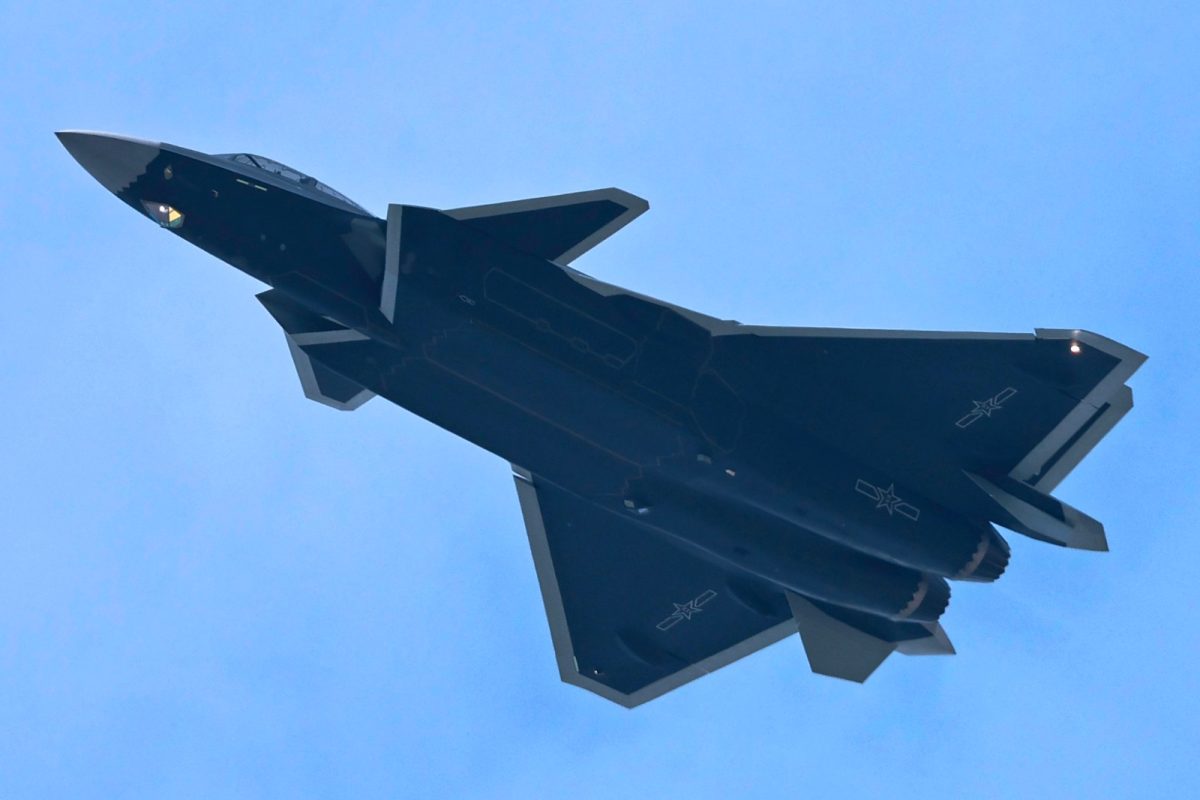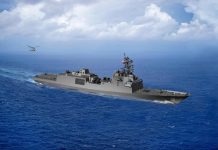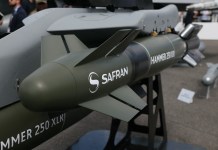The Chinese J-20S—the world’s first twin-seat fifth-generation combat aircraft—has been widely photographed while flying over China this month, triggering speculation that it is either about to or has already entered operational service with the People’s Liberation Army Air Force (PLAAF).
The images of the J-20A, the J-20S, and the latest fifth-generation aircraft of the PLAAF, the J-35A and its carrier-based variant, the J-35, have been regularly appearing on Chinese social media since early July.
Earlier this week, PLA military watchers reported that the J-35A has entered service with the PLAAF’s 1st Aviation Brigade, making China the second country in the world to operate two stealth fighters.
Although not officially verified, the appearance of the most recent J-20S has been widely believed to be linked to its induction, which would further expand China’s air power.
One of the many images posted online shows the J-20S with a five-digit serial number linked to the 172nd Air Brigade, a frontline PLAAF unit, as well as national insignia. This image has been interpreted as proof that the aircraft is either already operational or poised to enter service very soon.
The 172nd Air Brigade is based in Hebei and serves as both an advanced training unit and a combat reserve unit. In fact, it was the first unit to receive the J-20 Mighty Dragon.
J-20A/AS is in service Finally 🥂
Darker RAM coating
360° EOTS
WS10CXX engine (?)
78xxx should be 176thcc @Alfa_Particle pic.twitter.com/q2Lwk3qkaP
— Húrin (@Hurin92) July 4, 2025
China presented a scale model of the J-20S at the Airshow China 2024. The aircraft is based on the J-20 Mighty Dragon, which has been mass-produced and deployed to all five Chinese theatre commands.
According to experts, the forward fuselage of the J-20 was modified to accommodate a second crew member. The nosecone has been redesigned in comparison to previous J-20S models. Additionally, a hump behind the cockpit of the J-20S as compared to the J-20, may be an easier way to differentiate the two, as noted by a popular PLA analyst who goes by the name ‘Hurin’ on X.
Interesting 😯
As suspected this morning with the first still blurry photos, the J-20S not only carries PLAAF markings, but also a 5-digit serial number on the tail, with the 78xxx (?) being most likely one of the FTTB units like the 176th or 172nd Air Brigade. https://t.co/cUC0DGmf7e
— @Rupprecht_A (@RupprechtDeino) July 4, 2025
The J-20S features a more advanced electro-optical system installed beneath the nose. This news system provides 360-degree coverage and is quite similar to the F-35’s Electro-Optical Targeting System (EOTS), as emphasized by multiple dedicated PLA watchers. It is likely powered by the indigenous WS10C2 engine.
The operationalisation of the J-20S would mark a watershed moment for PLA aviation, particularly because the aircraft has no analogs in the world. It is an extraordinary feat for a country like China, which inducted its first stealth aircraft less than a decade ago, to create a better, tandem-seat variant of that aircraft.

The Russians have indicated that they are keen on developing a twin-seater variant of the Su-57, as recently pointed out by an Indian Air Force veteran and military expert, Squadron Leader Vijainder K. Thakur (retd), in an article for the EurAsian Times.
He drew attention to the fact that Russia’s United Aircraft Corporation published a patent for a Multifunctional two-seat stealth aircraft in 2023, which was easily recognizable as Su-57. However, the progress has been sluggish.
Meanwhile, China’s primary adversary, the US, does not have a twin-seat fifth-generation stealth fighter, despite being the first country in the world to develop a stealth aircraft. Neither the iconic F-117, nor the F-22 Raptor, nor the F-35 Lightning II has two-seat variants.
Historically, American fifth-generation fighters have prioritized single-seat configurations to reduce radar cross-section (RCS) and weight, aligning with the requirements for stealth and agility. Instead, the US has invested in cutting-edge avionics and networking to enable single-pilot operations, allowing a single pilot to manage complex duties that a twin-seat design might ordinarily perform, such as data fusion and drone coordination.
Nevertheless, a twin-seat variant gives some distinct advantages. For example, it facilitates pilot training and transition, which is particularly important for sophisticated fifth-generation systems. Moreover, assigning the second crew the role of handling sophisticated systems, data fusion, and electronic warfare operations could improve overall mission performance in a networked and data-centric combat environment.
The twin-seat stealth fighter could achieve greater capability as a deep strike aircraft when one pilot concentrates on flight and the other on weapons systems.
This might be essential if an enemy’s airspace, guarded by sophisticated Surface-to-Air (SAM) systems, needs to be breached.
The Chinese J-20S Is Here
The aircraft is classified as a new-generation, medium-to-long-range, two-seat, heavy multirole stealth fighter jet developed independently by China. According to the Aviation Industry Corporation of China (AVIC), the aircraft can conduct precision strikes on land and sea targets, as well as carry out medium- to long-range air superiority operations.
Speaking to state-owned Chinese publication Global Times during the aircraft’s debut in 2024, Chinese military analyst, Zhang Xuefeng said single-seat fighter jets evolved into two-seater variants because the two-seat fighter jets allowed senior pilots to train new pilots on the same aircraft, allowing a second pilot to handle complex operations like radar detection and missile attack.
A second operator would likely enhance human-machine interaction in information-rich environments, according to a 2024 analysis by the China Aerospace Studies Institute (CASI). This could provide China with an advantage in situations where quick decisions involving unmanned assets are needed.
The J-20S’s twin-seat configuration may allow it to perform tasks where a second crew member manages sensors or communications, such as electronic warfare, aerial command and control (C2), or precision-guided weapons coordination.
This could be extremely beneficial in contested airspace where single-seat pilots are challenged by electronic jamming or data overload.
For instance, in a war situation in the South China Sea, the J-20S might handle ISR (intelligence, surveillance, and reconnaissance) assets or coordinate drone strikes while remaining stealthy, possibly outperforming competing single-seat fighters.
A twin-seat J-20S could serve as a lead-in fighter trainer, reducing the need for separate training aircraft and allowing pilots to transition directly to operational stealth platforms. This could accelerate China’s ability to field experienced pilots, a critical factor in achieving air superiority in today’s world.
On its debut in November 2024, the aircraft was photographed with PL-15E, a Beyond Visual Range Air-to-Air Missile (BVRAAM) with a compact, foldable fin design. If integrated with the J-20S, it would significantly bolster the aircraft’s firepower, as the aircraft would be able to carry six of these due to its small size.
In the volatile Indo-Pacific region, where China has a home-field advantage, the J-20S could leverage its twin-seat capabilities to coordinate long-range strikes or counter US aircraft carrier groups. Its seamless integration with drones could disrupt US air operations, especially if paired with China’s enviable A2/AD (anti-access/area denial) network.
However, the above features might not automatically give China a tactical advantage against its adversaries.
The US Air Force (USAF) F-22 Raptor and F-35 Lightning II are both well-proven, fifth-generation aircraft that have undergone combat testing and received several new upgrades.
The F-35, in particular, integrates with systems like Link 16 and MADL (Multifunction Advanced Data Link), enabling seamless data sharing across joint forces. This network-centric warfare capability could offset the J-20S twin-seat advantage.
Additionally, US fighter pilots are heavily supported by Airborne Early Warning and Control Systems, such as the E-3 (to be succeeded by the more advanced E-7 Wedgetail).
The US is also heavily investing in Collaborative Combat Aircraft (CCA) programs. These autonomous drones are designed to operate with minimal human intervention, potentially negating the need for a second crew member.
For instance, the XQ-58A Valkyrie and other loyal wingman drones can perform strike, reconnaissance, or decoy roles, controlled via Artificial Intelligence or networked fighters, matching the J-20S’s Manned-Unmanned Teaming (MUMT) capability.
The US also benefits from a global network of bases and allies, such as Japan, South Korea, and Australia, which could enable the forward deployment of stealth fighters and Collaborative Combat Aircraft (CCAs). This distributed force structure could potentially counterbalance the J-20S’s localized advantages.
- Contact the author at sakshi.tiwari9555 (at) gmail.com
- Follow EurAsian Times on Google News




